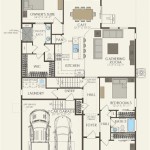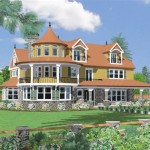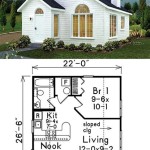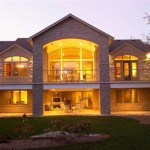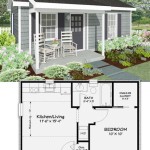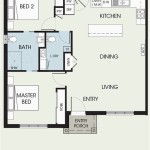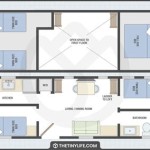Small Home Floor Plans: Maximizing Space in 2-Bedroom Designs
The allure of homeownership often encounters the reality of budget constraints and land availability. This frequently translates into a preference for smaller homes, particularly those with two bedrooms. Designing a functional and comfortable small home, however, requires careful planning and a strategic approach to floor plan design. This article explores various aspects of small home floor plans featuring two bedrooms, examining key considerations and design principles that optimize space and enhance livability.
Small home design is not merely about shrinking the dimensions of a larger home. It necessitates a shift in perspective, focusing on efficient use of every square foot. This encompasses several factors, including open concept layouts, strategic storage solutions, and thoughtful consideration of natural light and flow.
Prioritizing Open Concept Living
One of the most effective strategies for maximizing space in a small 2-bedroom home is the adoption of an open concept living area. This generally involves combining the living room, dining area, and kitchen into a single, unified space. The absence of dividing walls creates a sense of spaciousness and allows for better circulation of light and air. This approach also fosters a more social and interactive atmosphere within the home.
When implementing an open concept design, careful consideration must be given to zoning. While the space is open, delineating functional areas is crucial. This can be achieved through various methods, such as changes in flooring, the strategic placement of furniture, and the use of area rugs. For example, a large area rug can define the living room area, while a kitchen island can serve as a visual barrier between the kitchen and dining space. Similarly, changes in ceiling height or the use of architectural features, like columns or beams, can subtly define different zones without compromising the open feel.
Furthermore, the selection of furniture is paramount in an open concept small home. Multi-functional furniture, such as sofa beds or coffee tables with built-in storage, can significantly contribute to space optimization. Scaling furniture appropriately to the size of the room is also essential; oversized furniture can overwhelm the space and detract from the feeling of openness. Lighter colors and minimalist designs are generally preferred, as they tend to make the space feel larger and brighter.
Another key aspect of open concept living in small homes is minimizing clutter. A decluttered space will always appear more spacious and inviting. Implementing effective storage solutions throughout the open area, such as built-in shelving or hidden storage compartments, is vital for maintaining a tidy and organized environment. This is particularly important in the kitchen area, where counter space is often limited.
Lighting plays a crucial role in enhancing the open concept design. A combination of natural and artificial lighting can create a warm and inviting atmosphere. Large windows and skylights should be incorporated whenever possible to maximize natural light. Strategic placement of artificial lighting fixtures, such as recessed lighting, pendant lights, and floor lamps, can further illuminate the space and highlight specific features.
Optimizing Bedroom Design and Storage
In a small 2-bedroom home, the bedrooms need to be designed with both comfort and efficiency in mind. While the master bedroom is usually prioritized in terms of size, the second bedroom should not be overlooked. Both bedrooms must offer adequate sleeping space, storage, and sufficient room for movement.
Maximize space in the bedrooms by implementing smart storage solutions. Built-in wardrobes or closet organizers can significantly increase storage capacity without taking up valuable floor space. Consider utilizing vertical space by installing shelves or cabinets that reach the ceiling. Under-bed storage is another excellent option for stowing away items such as extra linens, seasonal clothing, or shoes.
The layout of the bedrooms should prioritize functionality and ease of movement. Placing the bed against a wall can free up floor space, while strategically positioning furniture can optimize traffic flow. In smaller bedrooms, consider using a smaller bed size, such as a full-size or even a twin-size bed, to maximize available space. Wall-mounted bedside tables or shelves can also save valuable floor space.
The use of color and lighting can significantly impact the perceived size of the bedrooms. Lighter colors tend to make a room feel larger and brighter, while darker colors can make it feel smaller and more enclosed. Incorporating natural light is also crucial for creating a welcoming and airy atmosphere. Large windows and skylights can bring in ample natural light, while sheer curtains can provide privacy without blocking the light completely.
In the second bedroom, which might serve as a guest room, home office, or children's room, flexibility is key. Multi-functional furniture, such as a sofa bed or a desk that can be folded away when not in use, can adapt the room to different needs. Consider incorporating storage solutions that can accommodate a variety of items, such as toys, books, or office supplies.
Strategic Use of Vertical Space and Light
In small home design, the exploitation of vertical space becomes paramount. Utilizing wall space for storage and decorative elements can significantly free up floor space, making the home feel more spacious and organized. Simultaneously, maximizing natural light intake and strategically placing artificial lighting can enhance the perceived size and ambiance of the home.
Vertical storage solutions are particularly beneficial in areas like the kitchen, bathrooms, and bedrooms. In the kitchen, tall cabinets that reach the ceiling can provide ample storage for pantry items, cookware, and appliances. Wall-mounted shelves and pot racks can further increase storage capacity without taking up valuable counter space. Similarly, in the bathroom, vertical shelving units or cabinets can store toiletries, towels, and other bathroom essentials.
In addition to storage, vertical space can also be used for decorative purposes. Wall-mounted artwork, mirrors, and shelving units can add visual interest and personality to the home without cluttering the floor. Mirrors are particularly effective in small spaces, as they reflect light and create the illusion of more space.
Maximizing natural light is crucial for creating a bright and airy atmosphere in a small home. Large windows and skylights should be incorporated whenever possible to bring in ample natural light. Placing windows strategically to capture sunlight throughout the day can significantly reduce the need for artificial lighting. Sheer curtains or blinds can provide privacy without blocking the light completely.
When natural light is limited, artificial lighting plays a vital role in illuminating the space. A combination of ambient, task, and accent lighting can create a warm and inviting atmosphere. Recessed lighting provides general illumination, while task lighting, such as under-cabinet lighting and desk lamps, provides focused light for specific tasks. Accent lighting, such as spotlights and wall sconces, can highlight architectural features or artwork.
The choice of lighting fixtures can also impact the perceived size of the home. Smaller, more discreet fixtures tend to make the space feel larger, while larger, more ornate fixtures can overwhelm the space. Lighter-colored fixtures are generally preferred, as they reflect light and create a brighter atmosphere.
Moreover, consider the placement of light fixtures in relation to furniture and architectural features. Placing a lamp next to a sofa or armchair can create a cozy reading nook, while highlighting a piece of artwork with a spotlight can draw attention to its beauty. Strategic placement of lighting fixtures can transform a small space into a warm, inviting, and functional home.
Careful planning and execution are essential for creating a comfortable and functional living space in a small 2-bedroom home. By prioritizing open concept living, optimizing bedroom design and storage, and strategically using vertical space and light, homeowners can maximize the potential of their small homes and create a living environment that is both aesthetically pleasing and highly functional.

The Best 2 Bedroom Tiny House Plans Houseplans Blog Com

Cottage Style House Plan 2 Beds 1 Baths 856 Sq Ft 14 239 Tiny Floor Plans Small

Unique 2 Bedrooms House Plans With Photos New Home Design De4 Small Floor Tiny Two Bedroom Plan

The Best 2 Bedroom Tiny House Plans Houseplans Blog Com

Modern Tiny House Plans 2 Bedroom Bathroom With Free Oragnal Cad File Small Floor Pool

2 Bedroom 992 Sq Ft Tiny Small House Plan With Porch 123 1042

Extremely Gorgeous 2 Bedroom House Plans Pinoy Designs

Floor Plan 2 Bedroom Tiny House Interior

The Best 2 Bedroom Tiny House Plans Houseplans Blog Com

10 Small House Plans With Open Floor Blog Homeplans Com

